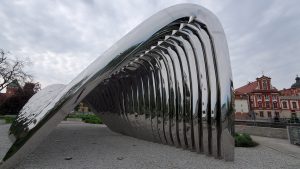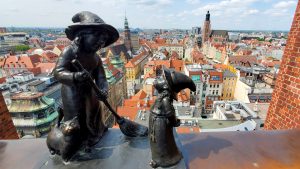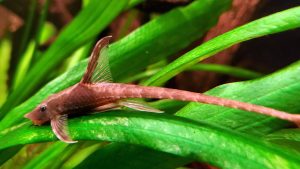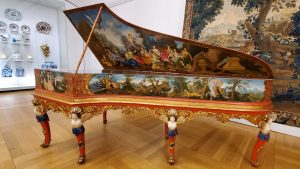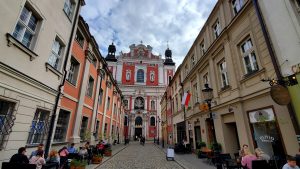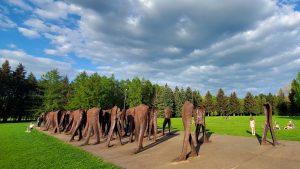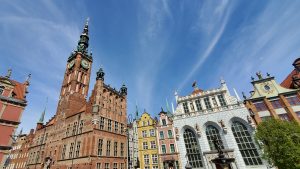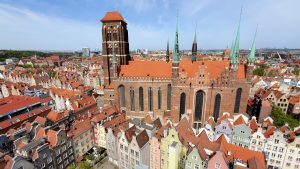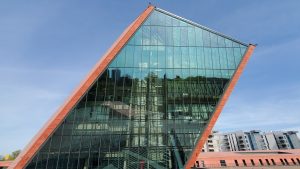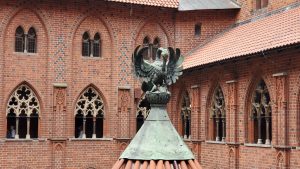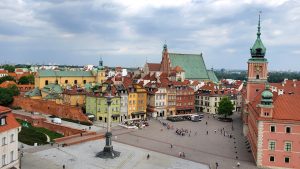We took a Flixbus from Kraków to Wrocław where we spent 3 nights. What a cute city to explore – home to over 600 bronze dwarfs and we probably stumbled upon half of them! Our hostel was located on the market square so we were perfectly situated to explore this beautiful city. We climbed 4 different towers for various vantage points of Wrocław, spent a full day at the world class zoo, and explored every nook and cranny of the city before catching a train to Poznań. The town square was unfortunately in the middle of major renovations but we still enjoyed checking out the old town. From Poznań we caught a train to Toruń, a UNESCO world heritage city on the Vistula River. It was an easy, compact city to explore on foot and we got the bonus of a sound and light fountain show at night. After leaving Toruń, we caught a bus to Gdańsk, a beautiful port city located on the Baltic coast of Poland. The main town was tastefully reconstructed after its destruction in WWII, with many of its buildings dating back to the 14th century. It was a stunning city to discover on foot and the rows of burghers’ houses seen from up high was an unforgettable sight. From Gdańsk, we hopped on a train for a day trip to the world’s largest castle, the 13th century Teutonic castle of Malbork which was well worth a visit. After leaving Gdańsk, we took a train back to Warsaw where we spent our last 2 nights in Poland in the old town. Poland was even more beautiful than we had hoped it would be and it was easy to explore via public transportation. Our next destination is the United Kingdom and we can’t wait!
![]()
Another view of Wrocław’s town hall
![]()
Zdrój Fountain in Wrocław town square
![]()
Old town houses in Wrocław
![]()
Beautiful houses at the main market square of Wrocław’s old town
![]()
Colorful buildings lining the west side of Plac Solny (Salt Square); Wrocław
![]()
Dwarf with a heart - one of over 600 dwarfs in the city of Wrocław
![]()
The garden of Ogród Ossolineum
![]()
NAWA sculpture on Daliowa Island; Wrocław
![]()
Looking out over Wrocław from the Cathedral of St. John the Baptist
![]()
African face mask at a museum inside the Cathedral of St. John the Baptist; Wrocław
![]()
Rear view of the Cathedral of St. John the Baptist
![]()
The Oratorium Marianum at Wrocław University is famous for its perfect acoustics
![]()
Bridge of Penitents (also called Witches’ Bridge) is a footbridge between the two towers of Mary Magdalene church
![]()
Wrocław Świebodzki train station was closed in 1991. Today, part of it is a theater and another part is an open air bar and food court
![]()
Robby next to a massive wine barrel at Wrocław Świebodzki train station
![]()
Regional police headquarters of Wrocław
![]()
The Anonymous Pedestrians - lifelike bronze statues walking into the ground; Wrocław
![]()
Dwarf named Franek drinking wine
![]()
View of the main square from St. Elizabeth’s church tower; Wrocław
![]()
Dwarf with buckets sitting on a water pump; Wrocław
![]()
Horse carriage in the old town of Wrocław at sunset
![]()
Wrocław market square at night
![]()
Asian elephant at the Wrocław Zoo. The zoo is one of Europe’s oldest zoos and has been open for over 150 years
![]()
A school of fish in the Afrykarium section of the Wrocław Zoo
![]()
Dabb spiny-tailed lizards
![]()
Siebenrock’s snake-necked turtle
![]()
A trainer with a brown fur seal
![]()
Greater spot-nosed monkey
![]()
Bronze dwarf reading a Glamour magazine
![]()
Prisoner dwarf in the old city jail; Wrocław
![]()
The bar at Hostel Stonewall, our LGBTQ-friendly hostel in Poznań
![]()
Poznań city view from the observation deck at the Royal Castle
![]()
Detail on the “Crucifixion Cross of Old Believers”; Poznań Museum of Applied Arts
![]()
Circa 1750 harpsichord painted with hunting and mythological scenes; Museum of Applied Arts in Poznań
![]()
Merchant houses in Poznań’s old market square
![]()
Bamberka statue in Poznań old town
![]()
Street leading to the pink-hued Poznań Fara (Mary Magdalene and St. Stanislaus Church)
![]()
Ceiling view of Poznań Fara
![]()
Poznań Post Office and City Hall
![]()
Statue of Zygi Latarnik (Zygi memorial lighthouse keeper)
![]()
Nierozpoznani sculpture in Poznań is a cluster of headless and armless statues wandering around in Citadel Park
![]()
Bronze statue of a woman with eggs in her basket; Toruń
![]()
Interior view of Saint Jacob’s Church; Toruń
![]()
Bridge Gate (Brama Mostowa); Toruń
![]()
The leading tower of Toruń
![]()
The old town hall of Toruń
![]()
Town hall tower lookout over Toruń
![]()
The Church of the Holy Spirit as seen from the Town Hall Tower; Toruń
![]()
Mały Młyn (small mill); Gdańsk
![]()
Dom Młynarza (Miller’s House), a half timbered house on Mill Island; Gdańsk
![]()
Baszta Słomiana (Straw Tower); Gdańsk
![]()
Atlas and Caryatid at the entrance to the National Bank of Poland
![]()
Pedestrian street in the old town of Gdańsk
![]()
View towards the Golden Gate, a historic Renaissance city gate in Gdańsk
![]()
Historic burgher houses; Gdańsk
![]()
Sphinx at the base of a house on Długi Targ (Long Market) street; Gdańsk
![]()
The facade of a building in old town Gdańsk
![]()
Ornate facade on a building on Długi Targ
![]()
Green Gate (Brama Zielona); Gdańsk
![]()
Looking from Motława River towards the Burghers’ Houses and the medieval port crane; Gdańsk
![]()
Polish Baltic Frédéric Chopin Philharmonic concert hall; Gdańsk
![]()
Mariacka Street, one of the prettiest streets in Gdańsk
![]()
Relief on a town house on Mariacka Street; Gdańsk
![]()
View of Gdańsk from the Town Hall tower
![]()
View of the historic tenement houses on Długi Targ (long market) street; Gdańsk
![]()
Intricate doorway on a tenement house in Gdańsk old town
![]()
Rows of tenement houses in Gdańsk as seen from St. Mary’s Basilica tower
![]()
Looking at Gdańsk’s town hall tower from the top of St Mary’s Church
![]()
The Royal Chapel (Kaplica Królewska) with St. Mary’s Basilica in the background; Gdańsk
![]()
Straganiarska (vendors) Gate
![]()
Museum of the Second World War; Gdańsk
![]()
Russian propaganda posters; World War II Museum in Gdańsk
![]()
Soviet T-34 tank at the WWII museum in Gdańsk
![]()
The Great Armoury (Wielka Zbrojownia)
![]()
The Golden Gate at dusk; Gdańsk
![]()
Dusk view of the burghers’ houses of Gdańsk
![]()
Visiting Malbork Castle, the largest castle in the world
![]()
Knights in battle - detail of the 13th century Malbork Castle which was founded by the Knights of the Teutonic Order
![]()
Malbork Castle is built entirely of red brick
![]()
Statues of Teutonic Knights at Malbork Castle
![]()
Jewelry box carved out of amber on display at the Amber Museum; Malbork Castle
![]()
17th century amber necklace on display at the Amber Museum section of Malbork Castle
![]()
Bridge leading to the High Castle section of Malbork
![]()
Detail of a carving above a doorway to St Anne’s Chapel; Malbork Castle
![]()
Malbork Castle once served as the headquarters of the Teutonic Knights
![]()
Carving of a Teutonic knight on horseback in the Chapter House section of Malbork Castle
![]()
Lion chair in the Chapter House, which was where the Teutonic Order decided state/foreign policy and elected their Grand Masters; Malbork Castle
![]()
Carved face at the base of a pillar; Malbork Castle
![]()
Devil at the entrance to a toilet; Malbork Castle
![]()
Exterior view of the castle walls; Malbork Castle
![]()
Decorative ceiling keystone of a man stabbing a bear; Malbork Castle
![]()
Carved figurines at the entrance to St Mary’s Church; Malbork Castle
![]()
Sculpture of a pelican on the roof of a well; Malbork Castle
![]()
14th century wooden keystones from the vault in the Cistercian nuns’ church in Chelmno; Malbork Castle museum
![]()
Malbork Castle complex consists of three sections - the High Castle, Middle Castle and Low Castle. Walls separate each section
![]()
Castle Square viewpoint from St Anne’s Tower; Warsaw
![]()
The “Little Insurgent” statue was built to commemorate the child soldiers who fought and died during the Warsaw Uprising of 1944
![]()
Warsaw Uprising Monument is a tribute to the Polish insurgents who fought in the failed attempt to end their city’s Nazi occupation
![]()
The Monument to the Ghetto Heroes commemorates the Warsaw Ghetto Uprising of 1943
![]()
Death of Saint Adalbert of Prague, Gniezno Doors; POLIN Museum
![]()
Military ceremony for the death of Josef Pilsudski in front of the Tomb of the Unknown Soldier
![]()
Cobblestone street in the Old Town section of Warsaw
![]()
Goodbye Poland, hello England!









